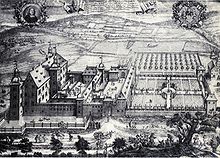Johann Adolf von Fürstenberg
Johann Adolf von Fürstenberg (born March 16, 1631 in Cologne , † April 14, 1704 in Herdringen ) was a Catholic clergyman (most recently cathedral provost in Paderborn and Münster ), as well as Drost in the Duchy of Westphalia , diplomat and builder of Adolfsburg Castle .
Origin and education
Johann Adolf von Fürstenberg was the youngest son of Landdrosten Friedrich von Fürstenberg and his wife Anna Maria von Kerpen. He received the beginnings of his school education in the Jesuit school in Siegen . In 1644 he moved to Paderborn for further training and received his first ordinations there in 1645. Together with his brother Ferdinand von Fürstenberg (later Prince-Bishop of Paderborn) he went to Rome in 1652 and studied there at the Collegium Romanum . When the financial means were exhausted, Johann Adolf had to return to Westphalia after a year.
Spiritual and secular offices
In 1658 he received a Kanonikerstelle at Münster Cathedral addition in 1661 a position at the Hildesheim Cathedral . On August 14, 1662 he received the position of Drosten for the offices of Bilstein , Waldenburg and Fredeburg from the Cologne elector Maximilian Heinrich von Bayern . Bilstein and Fredeburg were still hereditary pledges of the von Fürstenberg family until 1680 when the Cologne electors had paid off a loan. In 1664 another benefice was added to the cathedral in Paderborn . In 1668 he received the provost of the Holy Cross in Hildesheim. He was also appointed to the secret Paderborn council in 1674.
Diplomatic missions
Johann Adolf was important as a diplomat in the service of various gentlemen. In 1665 he was the ambassador of the Prince-Bishop of Münster Christoph Bernhard von Galen and played a role in the preparation of the first war against the Dutch States General . A year later he was part of the delegation from Munster who negotiated and sealed a peace treaty with the Dutch embassy in Kleve . A few years later he represented the interests of the estates of the Duchy of Westphalia in Vienna . The reason was that during the Imperial War against France from 1673 to 1675 the inhabitants of the duchy were heavily burdened with billeting, marching through and contributions from imperial and allied troops. In order to get better, von Fürstenberg traveled to Vienna with the Menden judge Johann Heinrich Schmitmann. They obtained the promise from Emperor Leopold I that the Sauerland should no longer become a transit area in the future. However, the military commanders refused this promise. Ernst after the bribe with a few thousand thalers and a delivery of Westphalian ham, the generals also supported the promise. Nevertheless, for similar reasons, von Fürstenberg felt compelled to travel to Vienna in 1676 and 1677. In the following years Johann Adolf undertook a few more embassies to Trier and Mainz . In the following years he hardly played a role politically. In 1683 he had also refused an appointment as a land defender.
Builder and founder
Although Johann Adolf von Fürstenberg was only a later son, he still had the task of administering the family property. In 1676 he had the Adolfsburg Castle built near Oberhundem and achieved that this property was elevated to a noble mansion by Emperor Leopold. That is why the estates recognized that they were free of valuation. However, Johann Adolf failed with the planned purchase of the Büren-Ringelstein estate due to the reluctance of the family council. After his nephew Ferdinand von Fürstenberg came of age, Johann Adolf also gave up the management of the family property. In the following years he lived alternately on the Adolfburg and in order to fulfill his residence duty as a canon in Münster, Paderborn and Hildesheim.
During his time as a diplomat, Johann Adolf made numerous spiritual foundations. In 1670 he had the Franciscan Church in Attendorn rebuilt. In 1684 he financed the construction of the Capuchin Church in Rüthen . Two years later he had a chapel in Paderborn Cathedral renewed. He also donated altars there and in Limburg . He donates a monstrance for the church in Oberhundem . In 1681 Johann Adolf was elected cathedral provost in Paderborn and in 1701 had a new cathedral provost office built.
Johann Adolf died in Herdringen in 1704 and was buried in the Attendorn Franciscan Church.
See also
literature
- Otto Höffer: Johann Adolf von Fürstenberg (1631-1704) . In: Michael Gosmann (Ed.): Fürstenberg sketches - forays through 700 years of Westphalian families and regional history. Arnsberg, 1995. pp. 71-73.
- Fürstenberg's story. Third volume. The history of the von Fürstenberg family in the 17th century. Edited by Helmut Lahrkamp, Helmut Richtering , Manfred Schöne and Gerhard Theuerkauf . Münster 1971. Article "Johann Adolf von Fürstenberg" by Helmut Lahrkamp, pp. 159–168.
Individual evidence
- ↑ Details on the appointment in the historical diary of the city of Attendorn
- ↑ Letter of Attenorner Gografen to von Furstenberg on foreign troops in Attendorn from April 10, 1673
- ↑ Helmut Lahrkamp: A report on the state of the Sauerland from 1677. In: Westfälische Zeitschrift Bd. 116 1966 pp. 101-107
- ^ Information about the imperial deed of February 20, 1676
- ↑ On the foundation of a baroque gate at the Rüthener Kapuzinerkirche ( Memento from April 2, 2008 in the Internet Archive )
- ^ Correspondence on the monstrance of January 21, 1680
| personal data | |
|---|---|
| SURNAME | Fürstenberg, Johann Adolf von |
| BRIEF DESCRIPTION | Catholic clergyman, also Drost in the Duchy of Westphalia, diplomat and builder of Adolfsburg Castle |
| DATE OF BIRTH | March 16, 1631 |
| PLACE OF BIRTH | Cologne |
| DATE OF DEATH | April 14, 1704 |
| Place of death | Herringring |


